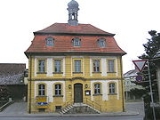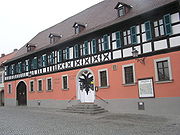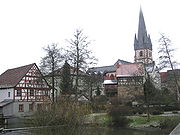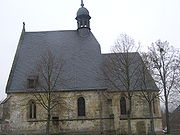
Baunach
Encyclopedia
Baunach is a town in the Upper Franconia
n district of Bamberg
and the seat of the administrative community (Verwaltungsgemeinschaft) of Baunach. Until administrative reform in 1972, Baunach belonged to the Lower Franconia
n district of Ebern.
Baunach calls itself the “Franconian Three-River Town” because it lies on the rivers Baunach, Lauter and Main. These three rivers are depicted in the town’s coat of arms
, in which a golden pike
lies over the three rivers. In 2002, the town celebrated its 1,200-year jubilee. Moreover, the river Itz
flows through the community area.
The name Baunach comes from the Indo-Germanic word for river: bunahu. This may be translated as “swelling water”. For thousands of years the entire region near Baunach has been populated by Celts and Franconians.
.
Kraiberg (with a hight of 365 meters) and Stiefenberg (396 meters high) are the most important mountains in the area. Baunach lies within the Hassberge
and thus is member city of the Haßberge Nature Park
.
The town also has these traditional rural land units, known in German
as Gemarkungen: Appendorf, Baunach, Daschendorf, Dorgendorf, Priegendorf, Reckenneusig, Stiefenberg, Daschendorfer Forst, Lußberger Forst.
The last-named two are wooded areas without any inhabitant. It is traditional for a Gemarkung to be named after a town or village lying nearby.
is populated for thousands of years. Emperor Ludwig the Bavarian
bestowed upon Baunach town rights in 1328. The town was both an Obervogtamt (“higher reeve’s office”) and headquarters of a famous regional knight county before Secularization
and belonged to the Prince-Bishopric of Bamberg. In 1727, the last execution was carried out in Baunach. In 1803 Baunach came to Bavaria
as a result of the Reichsdeputationshauptschluss. After World War II
many refugees came to Baunach.
In 1999 the town’s tax revenue, converted to euro
s, was €1,791,000, of which business taxes (net) amounted to €414,000.
(not the colours, though – they only came later) to appear in the town’s arms: “sullen steen drey wasserfluss. Und durch dieselben drey wasserfluss soll ein gantzer hecht mit dem haupt von der einen obern ecke des schilts.... geen.” (“shall stand three rivers. And through the same three rivers shall go a whole pike with the head from the one upper corner of the shield”).
The three rivers are the Baunach, the Lauter and the Main. The pike symbolizes the town’s wealth of fish. Prince-Bishop Johann Philipp von Gebsattel (1599–1609) completed the coloured arms with the following colours: red for the field, silver for the rivers and gold for the pike.


.jpg)


The local organists are Hubert Reinhard, who is vice-organist of the Basilica minor in Vierzehnheiligen, Marga Büttner, Alexander Schmitt and Matthias Bahr.
Market).
Upper Franconia
Upper Franconia is a Regierungsbezirk of the state of Bavaria, southern Germany. It forms part of the historically significant region of Franconia , all now part of the German Federal State of Bayern .With more than 200 independent breweries which brew...
n district of Bamberg
Bamberg (district)
Bamberg Land is a district in Bavaria, Germany. It surrounds but does not include the town of Bamberg. The district is bounded by the districts of Lichtenfels, Bayreuth, Forchheim, Erlangen-Höchstadt, Neustadt -Bad Windsheim, Kitzingen, Schweinfurt and Haßberge.- History :The history of the...
and the seat of the administrative community (Verwaltungsgemeinschaft) of Baunach. Until administrative reform in 1972, Baunach belonged to the Lower Franconia
Lower Franconia
Lower Franconia is one of the three administrative regions of Franconia in Bavaria , Germany ....
n district of Ebern.
Baunach calls itself the “Franconian Three-River Town” because it lies on the rivers Baunach, Lauter and Main. These three rivers are depicted in the town’s coat of arms
Coat of arms
A coat of arms is a unique heraldic design on a shield or escutcheon or on a surcoat or tabard used to cover and protect armour and to identify the wearer. Thus the term is often stated as "coat-armour", because it was anciently displayed on the front of a coat of cloth...
, in which a golden pike
Esox
Esox is a genus of freshwater fish, the only living genus in the family Esocidae — the esocids which were endemic to North America, Europe and Eurasia during the Paleogene through present.The type species is E. lucius, the northern pike...
lies over the three rivers. In 2002, the town celebrated its 1,200-year jubilee. Moreover, the river Itz
Itz
The Itz is a river in Germany and a right tributary of the Main.The Itz begins in Sachsenbrunn , Thuringia and flows southward through Bachfeld and Schalkau. It crosses into Bavaria and feeds the Froschgrundsee reservoir. It continues through Dörfles-Esbach, Coburg, and Großheirath, then is...
flows through the community area.
The name Baunach comes from the Indo-Germanic word for river: bunahu. This may be translated as “swelling water”. For thousands of years the entire region near Baunach has been populated by Celts and Franconians.
Geography
Baunach lies on the right bank of the Main, 11 km north of BambergBamberg
Bamberg is a city in Bavaria, Germany. It is located in Upper Franconia on the river Regnitz, close to its confluence with the river Main. Bamberg is one of the few cities in Germany that was not destroyed by World War II bombings because of a nearby Artillery Factory that prevented planes from...
.
Kraiberg (with a hight of 365 meters) and Stiefenberg (396 meters high) are the most important mountains in the area. Baunach lies within the Hassberge
Haßberge Hills
The Haßberge Hills are a 512,2 m over zero high hill chain north of the Main River in Lower Franconia, Bavaria, Germany. On the other side of the Main Valley is the Steigerwald....
and thus is member city of the Haßberge Nature Park
Haßberge Nature Park
Haßberge Nature Park is a park of located in the north east of Franconian Keuperland in Bavaria, Germany.- Isolated castles and ruins:The park has a large number of isolated castles and ruins which are integrated into the park's well marked walking paths....
.
Constituent communities
Baunach’s main town and namesake centre is by far the biggest of its Ortsteile with a population of 3,069. The town furthermore has these outlying centres, each given here with its own population figure:- Daschendorf 88
- Dorgendorf 342
- Godelhof 13
- Godeldorf 56
- Leucherhof 2
- Priegendorf 345
- Reckenneusig 227
The town also has these traditional rural land units, known in German
German language
German is a West Germanic language, related to and classified alongside English and Dutch. With an estimated 90 – 98 million native speakers, German is one of the world's major languages and is the most widely-spoken first language in the European Union....
as Gemarkungen: Appendorf, Baunach, Daschendorf, Dorgendorf, Priegendorf, Reckenneusig, Stiefenberg, Daschendorfer Forst, Lußberger Forst.
The last-named two are wooded areas without any inhabitant. It is traditional for a Gemarkung to be named after a town or village lying nearby.
History
The first sources of a city calles Baunach date from the year 802. Nevertheless the entire region from Baunach to the StaffelbergStaffelberg
Staffelberg is a mountain of Bavaria, Germany. It is part of the Franconian Switzerland and one of the most important landmarks in Franconia. First settlements date from the neolithic Stone Age. Romans, Celts and Franconians followed. Nowadays, it is a famous tourists' attraction - not only because...
is populated for thousands of years. Emperor Ludwig the Bavarian
Louis IV, Holy Roman Emperor
Louis IV , called the Bavarian, of the house of Wittelsbach, was the King of Germany from 1314, the King of Italy from 1327 and the Holy Roman Emperor from 1328....
bestowed upon Baunach town rights in 1328. The town was both an Obervogtamt (“higher reeve’s office”) and headquarters of a famous regional knight county before Secularization
Secularization
Secularization is the transformation of a society from close identification with religious values and institutions toward non-religious values and secular institutions...
and belonged to the Prince-Bishopric of Bamberg. In 1727, the last execution was carried out in Baunach. In 1803 Baunach came to Bavaria
Bavaria
Bavaria, formally the Free State of Bavaria is a state of Germany, located in the southeast of Germany. With an area of , it is the largest state by area, forming almost 20% of the total land area of Germany...
as a result of the Reichsdeputationshauptschluss. After World War II
World War II
World War II, or the Second World War , was a global conflict lasting from 1939 to 1945, involving most of the world's nations—including all of the great powers—eventually forming two opposing military alliances: the Allies and the Axis...
many refugees came to Baunach.
Population development
Within the town’s area, 2,914 inhabitants were counted in 1970, 3,174 in 1987 and 3,807 in 2000. On 30 June 2007 it was 3,933.Town council
| 2002 | CSU Christian Social Union of Bavaria The Christian Social Union in Bavaria is a Christian democratic and conservative political party in Germany. It operates only in the state of Bavaria, while its sister party, the Christian Democratic Union , operates in the other 15 states of Germany... |
SPD Social Democratic Party of Germany The Social Democratic Party of Germany is a social-democratic political party in Germany... |
Christlicher Bürgerblock Baunach (BBB) (Christian Citizens' Block) | Christliche Wählerunion (CWU) (Christian Voters' Union) | TOTAL |
|---|---|---|---|---|---|
| Seats | 6 | 4 | 5 | 1 | 16 |
In 1999 the town’s tax revenue, converted to euro
Euro
The euro is the official currency of the eurozone: 17 of the 27 member states of the European Union. It is also the currency used by the Institutions of the European Union. The eurozone consists of Austria, Belgium, Cyprus, Estonia, Finland, France, Germany, Greece, Ireland, Italy, Luxembourg,...
s, was €1,791,000, of which business taxes (net) amounted to €414,000.
Coat of arms
On 15 July 1447, the Bamberg Bishop Anton von Rotenhan conferred upon the market town of Baunach “ein sigill und panir” (“a seal and banner”). He made clear the chargesCharge (heraldry)
In heraldry, a charge is any emblem or device occupying the field of an escutcheon . This may be a geometric design or a symbolic representation of a person, animal, plant, object or other device...
(not the colours, though – they only came later) to appear in the town’s arms: “sullen steen drey wasserfluss. Und durch dieselben drey wasserfluss soll ein gantzer hecht mit dem haupt von der einen obern ecke des schilts.... geen.” (“shall stand three rivers. And through the same three rivers shall go a whole pike with the head from the one upper corner of the shield”).
The three rivers are the Baunach, the Lauter and the Main. The pike symbolizes the town’s wealth of fish. Prince-Bishop Johann Philipp von Gebsattel (1599–1609) completed the coloured arms with the following colours: red for the field, silver for the rivers and gold for the pike.
Sport and leisure facilities
- footballFootball (soccer)Association football, more commonly known as football or soccer, is a sport played between two teams of eleven players with a spherical ball...
field - tennisTennisTennis is a sport usually played between two players or between two teams of two players each . Each player uses a racket that is strung to strike a hollow rubber ball covered with felt over a net into the opponent's court. Tennis is an Olympic sport and is played at all levels of society at all...
court - indoor swimming poolSwimming poolA swimming pool, swimming bath, wading pool, or simply a pool, is a container filled with water intended for swimming or water-based recreation. There are many standard sizes; the largest is the Olympic-size swimming pool...
- skating track
- bathing lake
- fishing pond
- boarding and landing stage for the Kanuerlebnis Obermain (“Upper Main Canoe Experience” – planned)
Culture and sightseeing


.jpg)


Museums
The Heimatmuseum Baunach (“homeland” or local museum) at the Old Town Hall has exhibits from the town’s and the parish’s prehistory and early history as well as from Baunach’s club life. There are also agricultural devices and others from historical crafting as well as from town and country households. In the town hall’s former session chamber is found a comprehensive collection by painter and graphic artist Max Schnös.Buildings
- The historic marketplaceMarketplaceA marketplace is the space, actual, virtual or metaphorical, in which a market operates. The term is also used in a trademark law context to denote the actual consumer environment, ie. the 'real world' in which products and services are provided and consumed.-Marketplaces and street markets:A...
with timber-frameTimber framingTimber framing , or half-timbering, also called in North America "post-and-beam" construction, is the method of creating structures using heavy squared off and carefully fitted and joined timbers with joints secured by large wooden pegs . It is commonplace in large barns...
houses, among them the Obleyhof, first mentioned in a document in 1385, which was owned by the BambergBambergBamberg is a city in Bavaria, Germany. It is located in Upper Franconia on the river Regnitz, close to its confluence with the river Main. Bamberg is one of the few cities in Germany that was not destroyed by World War II bombings because of a nearby Artillery Factory that prevented planes from...
Cathedral Capitular. Each new Cathedral Capitular received the Hof as an Obley (“bonus”); fountainFountainA fountain is a piece of architecture which pours water into a basin or jets it into the air either to supply drinking water or for decorative or dramatic effect....
with statueStatueA statue is a sculpture in the round representing a person or persons, an animal, an idea or an event, normally full-length, as opposed to a bust, and at least close to life-size, or larger...
of the late Überkum - The Parish Church, consecrated to Saint OswaldSaint OswaldSaint Oswald may refer to:*Oswald of Northumbria , King of Northumbria*Oswald of Worcester , Archbishop of York...
, with tower from the year 1244 and the choir from about 1460. Beside the church is found a former two-story charnel houseCharnel houseA charnel house is a vault or building where human skeletal remains are stored. They are often built near churches for depositing bones that are unearthed while digging graves...
. The great church pipe organ exists of the following organ stopsOrgan stopAn organ stop is a component of a pipe organ that admits pressurized air to a set of organ pipes. Its name comes from the fact that stops can be used selectively by the organist; some can be "on" , while others can be "off" .The term can also refer...
(translated as far as possible):
|
|
|
|
The local organists are Hubert Reinhard, who is vice-organist of the Basilica minor in Vierzehnheiligen, Marga Büttner, Alexander Schmitt and Matthias Bahr.
- The Late Gothic Magdalenenkapelle (chapelChapelA chapel is a building used by Christians as a place of fellowship and worship. It may be part of a larger structure or complex, such as a church, college, hospital, palace, prison or funeral home, located on board a military or commercial ship, or it may be an entirely free-standing building,...
, built about 1430, expanded in 1473 with the endowment from the late Überkum) at the graveyardGraveyardA graveyard is any place set aside for long-term burial of the dead, with or without monuments such as headstones...
; inside is found a high altarAltarAn altar is any structure upon which offerings such as sacrifices are made for religious purposes. Altars are usually found at shrines, and they can be located in temples, churches and other places of worship...
from 1693 and the late Überkum’s grave. Its organ is a special attraction including a rare organ effect stop called Rossignol ("Vogelschrey") which imitates the sound of singing birds. - The Zentscheune (“tithe barn”); here, the titheTitheA tithe is a one-tenth part of something, paid as a contribution to a religious organization or compulsory tax to government. Today, tithes are normally voluntary and paid in cash, cheques, or stocks, whereas historically tithes were required and paid in kind, such as agricultural products...
s were stored, the tax for the Holzkirchen Convent in Fulda. - The Schächer, a small chapel with a wooden cross from 1520. It lies on the way to the former execution place.
- Old Town Hall, called Schloss Schadeck, built between 1742 and 1746 by master builder Justus Dientzenhofer; today houses the Heimatmuseum.
- Remains of the old town wall with Marienmarter (Martyrdom of Mary) from about 1720
- The prince-bishop’s Amtsschloss (“Office Palace”), also called the hunting palace, a Late BaroqueBaroqueThe Baroque is a period and the style that used exaggerated motion and clear, easily interpreted detail to produce drama, tension, exuberance, and grandeur in sculpture, painting, literature, dance, and music...
building built by the Prince-Bishop of Bamberg Marquard Sebastian Schenk von Stauffenberg, and completed by his successor Prince-Bishop Lothar Franz von SchönbornLothar Franz von SchönbornLothar Franz von Schönborn was the Archbishop-Elector of Mainz from 1694 until 1729, and the Bishop of Bamberg from 1693 until 1729.Lothar Franz was born in Steinheim am Main in 1655 to Count Philip Erwin of Schönborn...
. - The “Wooden Men”, an oaken gate with two men. It once stood before the building across the street, the old Kastenhof, which housed the courtCourtA court is a form of tribunal, often a governmental institution, with the authority to adjudicate legal disputes between parties and carry out the administration of justice in civil, criminal, and administrative matters in accordance with the rule of law...
from 1710 to 1803.
Regular events
Baunach holds a Kirchweih (church consecration festival), Altstadtfest (old town festival), Magdalenenmarkt (Magdalen Market) and Weihnachtsmarkt (ChristmasChristmas
Christmas or Christmas Day is an annual holiday generally celebrated on December 25 by billions of people around the world. It is a Christian feast that commemorates the birth of Jesus Christ, liturgically closing the Advent season and initiating the season of Christmastide, which lasts twelve days...
Market).
Further reading
- A. Schenk: Chronik von Baunach. 1924
- Karl Krimm: Stadt und Amt Baunach. 1974
- Chronik der Stadt Baunach. 2002
- Baunach. Festschrift der Stadt Baunach zur 1175-Jahrfeier und zur 650. Wiederkehr der Verleihung des Stadtrechtes (historical and statistical information about the town).

